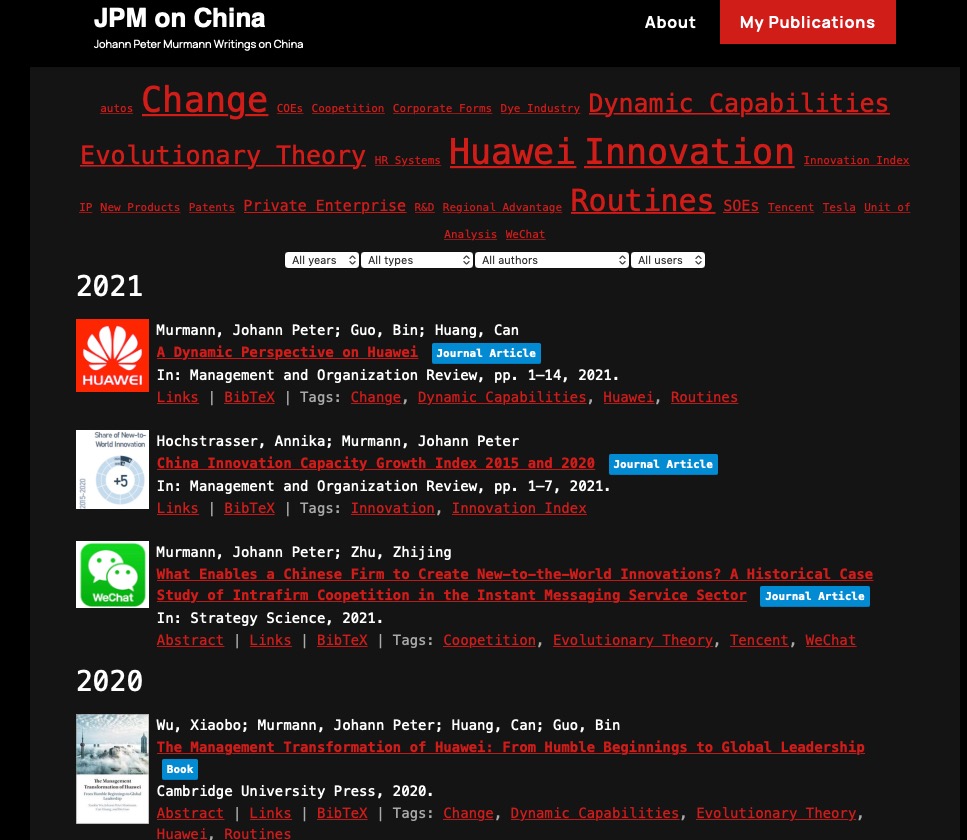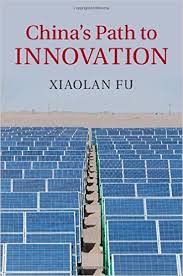
Research Focus on Auto Industry
My research team is interested in studying how to improve strategic forecasting ability. As a key empirical context, we have selected the auto industry undergoing dramatic technological changes.
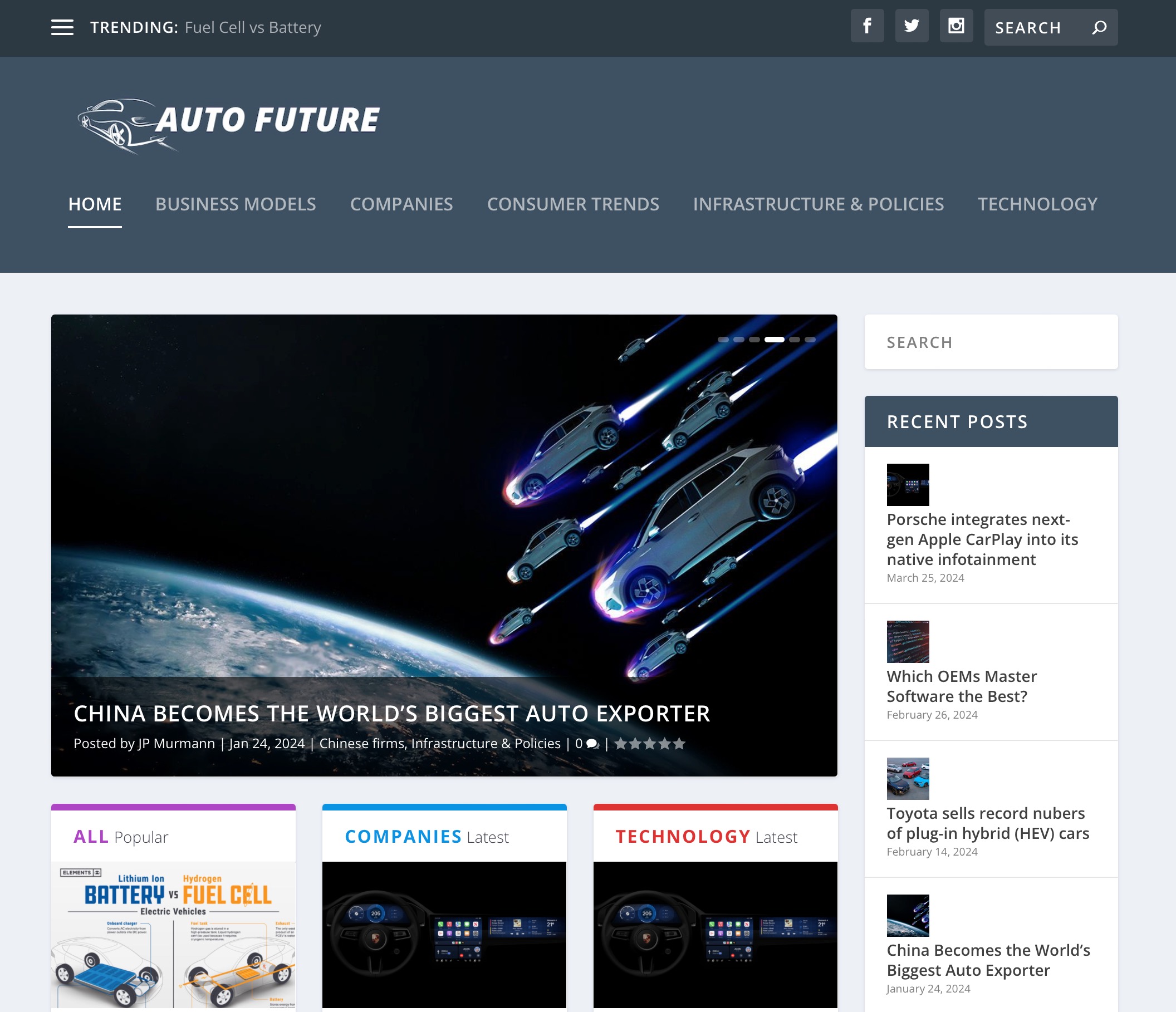
Click on the picture to access auto-future.org
Categories: Innovation | Management |

New Competition in the auto industry: Incumbents versus startups
I have two new publications about the new competition in the auto industry.
A Capabilities Framework for Dynamic Competition: Assessing the Relative Chances of Incumbents, Start-Ups, and Diversifying Entrants (with Fabian Vogt in Management and Organization Review)
Exploring the structure of internal combustion engine and battery electric vehicles: implications for the architecture of the automotive industry (with Benedikt Schuler in Industrial and Corporate Change)
Categories: Innovation | Management | Writing |

Forum on ‘The Rise of China’s Digital Economy’
In this forum, we present three essays that collectively seek to document and explain the rise of China’s digital economy. The first essay written by Hong Jiang – who is based in China – and myself – who is based in the West – focuses on documenting the rise of China’s digital economy by comparing it systematically with developments in the United States (Jiang & Murmann, 2022). This first essay intentionally says relatively little about the causes driving the rise so that the two invited teams of commentators could focus on reasons behind the growth of e-commerce and internet services in China. The first team, composed of Chong Ma, Ji-Ye Mao, and Xiao-Peng An (2022), is based in China and the second team, composed of Martin Kenney and Arie Y. Lewin (2022), is based in the United States. Both teams were provided with the opening essay and a set of questions to stimulate a debate about causes.
• Is the increasing strength of these digital sectors intimately tied to government policies? If so, how?
• Is the fact that China is much more lax about privacy a critical reason for the advances in China?
• Will China overtake the US in these digital services or will the fast growth slowdown?
• On the assumption that the geopolitical struggles between China and the US continue to rise, what, if any implications will this have for the further development of e-commerce and digital services companies in China and the US?
• The Chinese government recently has made it more difficult for Chinese firms to list on US stock exchanges; will this have a negative impact?
Categories: China | Innovation | Economics |
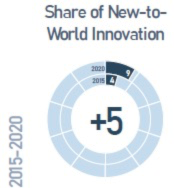
China Innovation Capacity Growth Index 2015 and 2020
It is of interest in China and across the world to predict whether China will catch up with the most economically advanced nations in innovation capacity. To facilitate an ongoing assessment of China’s innovation capacity, the article develops a China Innovation Capacity Growth Index composed of eight separate measures. China’s performance in 2020 is compared to the baseline from 2015, showing that China has progressed in six of the eight measures. This article and the accompanying Technicalm Appendix explain each of the measures, including the sources for the data, and report
the changes in performance over time.
Download article here: China Innovation Capacity Growth Index 2015 and 2020
Categories: China | Innovation | Management |

My Writings on Chinese Firms and Innovation in the Chinese Economy
I collected all my Writings on Chinese Firms and Innovation in the Chinese Economy in one place.
Categories: China | Innovation | Publications | Writing |

Excerpt from Last Interview with Jim March
Peter Ping Lee interviews James March. I provide here what I personally found the most interesting part of the full interview.
Peter: In your MOR 2005 article (March 2005), you referred to the peripheral position of the indigenous research communities relative to the mainstream research community. Do you think the Chinese research community is like that?
James: So far as possible, we would like to maintain some diversity. The ideology of research is international and sharing, but the risk is that you converge too completely and too fast. So how do you keep it from converging too rapidly and too completely? National and other communities being separate is our way to maintain diversity. It is a complicated problem because, from the point of the view of the separate community, that is not advantageous; they will be more advantageous if they converge with the dominant view; from the point of the view of the total community, there is an advantage having diversity. One of the ways to maintain that diversity in our present world situation is being national with a combination of separate cultures, separate languages, and some kind of local enthusiasm. Whether maintaining the optimum diversity is a much more complicated question, but a completely convergent is not optimum, so you need some diversity.
Peter: Is this analogous to the argument that if you don’t maintain exploration, then there is a tendency that the community will convert into exploitation?
James: It can be framed as exploitation-exploration issue. And that issue arises in all places, and in all places that I know, we have no optimum solution to it. We don’t know what the best mix is, but we know that is not the extremes. Diverse totally is not what you really want to be, but how much diversity you want is very complicated. Some parts are very simple. The longer you look ahead, the more you want diversity; the shorter your time perspective, the less you want diversity; that is fought over and over again. And some areas we have theorems that show that is true. The one I know best is the two-armed bandit world.
That is a set of problems that can be characterized as like going to a casino and confronting a whole array of slot machines. You know these slot machines have different payoffs. But you don’t know which one is the best, so you start experimenting. What is your search rule? After a while, you have found one that appears to be the best. And obviously, you will do well by repeating that rule. But when you repeat that one, you don’t search for any other ones. If you search for another one, you do less well in the short run, but you might do better in the long run. We don’t have any real solution to that problem. We do not know how to determine the optimum outcome.
Categories: China | Management | Methodology |
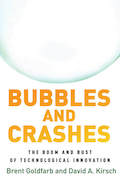
Review of “Bubbles and Crashes” by Brent Goldfarb and David A. Kirsch
Brent Goldfarb and David A. Kirsch. Bubbles and Crashes: The Boom and Bust of Technological Innovation. Stanford, CA: Stanford University Press, 2019. 247 pp. $35.00, cloth.
Financial bubbles have been a recurring phenomenon throughout the history of capitalism that have proved costly for society. According to the U.S. Bureau of Economic Analysis, the most recent financial crisis from 2007 to 2009 resulted in a real GDP loss of $650 billion. The U.S. Government Accountability Office (2013: 12) called it the “most severe economic downturn since the Great Depression of the 1930s.”
Given that financial bubbles are more the domain of finance scholars and economists, why should ASQ readers read a book on Bubbles and Crashes? Its subtitle—The Boom and Bust of Technological Innovation—is what makes the book interesting for organizational scholars. Beginning with the famous Aston studies, organizational scholars have increasingly focused on technology as a key shaper, first of individual organizations (Hage and Aiken, 1969) and later of entire populations of organizations (Tushman and Anderson, 1986). The recent interest in “disruption” typically involves a new technology that a startup develops for a niche market. Subsequently the technology is so much improved that the startup can bring it to the core market where it disrupts the leadership position of incumbent firms (Christensen, 1997). Goldfarb and Kirsch extend this literature by examining the role of technological innovation in the formation of bubbles in financial markets. They aim to identify the key causal mechanisms that increase the likelihood of the formation of a speculative bubble.
The book is divided into six chapters. After a brief introduction outlining the most important elements of their theory about the formation of speculative bubbles, chapter 1 introduces the central concepts necessary to differentiate bubbles from non-bubbles. Bubbles are those “boom and bust episodes in which investors drive up prices and get fooled” (p. 24). To determine whether there is a bubble, the authors develop a measure called “frothiness” that represents “the number of standard deviations from the predicted stock or index trend . . . where the ‘trend’ is the predicted stock price looking forward and backward seven years” (p. 35). In short, the measure indicates whether stock prices are inflated. If the frothiness is larger than 2, the stock price is a candidate for a bubble, but the authors bring to bear additional judgments to determine whether investors were fooled. Chapter 2 describes the role of uncertainty and narratives in the formation of bubbles. The authors differentiate four types of uncertainty: technological uncertainty, competitive uncertainty, business model and value chain uncertainty, and demand uncertainty. And they conceptualize narratives—which emerge in an unexpected starring role in the book––as “temporally sequenced accounts of interrelated events or actions undertaken by characters” (p. 51). Chapter 3 explains what role novices, naïfs, and biases play in the formation of bubbles. While chapters 2 and 3 constitute Goldfarb and Kirsch’s theory on the causes of speculative bubbles driven by technological innovation, chapter 4 applies their framework to a sample of technologies to test its explanatory power. In chapter 5 Goldfarb and Kirsch test the external validity of their theory by applying the framework to a different sample of more recent technologies. Chapter 6 derives policy implications from the framework and gives practical advice on how one can assess the probability of being in a bubble. The appendix provides further information on the methods, a summary of the main findings in tables, and a comprehensive list of sources used for writing the detailed histories of the technologies.
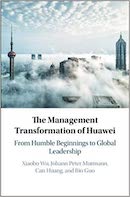
The Management Transformation of Huawei: From Humble Beginnings to Global Leadership
Huawei has become China’s most prominent multinational company and a leader in the ICT sector. Given unprecedented access to the company, the authors of this book examine the management transformation of Huawei from its inception in 1987 until 2019, observing in detail not only the creation of its organizational routines but also the breaking of routines across most major functional areas: Management, Product Development, HR, Supply Chain, Finance, R&D, Intellectual Property, and International Business. ‘Dynamic capabilities’ are central to theories of competitive advantage and this book highlights Huawei as an ideal case study for the successful implementation of change routines and change-supporting values. The chapters cover all the major change initiatives the firm has undertaken since 1996 to import best practices from the West, with the help of consultants. The insights presented in the book will be particularly interesting for academics in the field of strategy, management, and business history.
Table of Contents and ordering
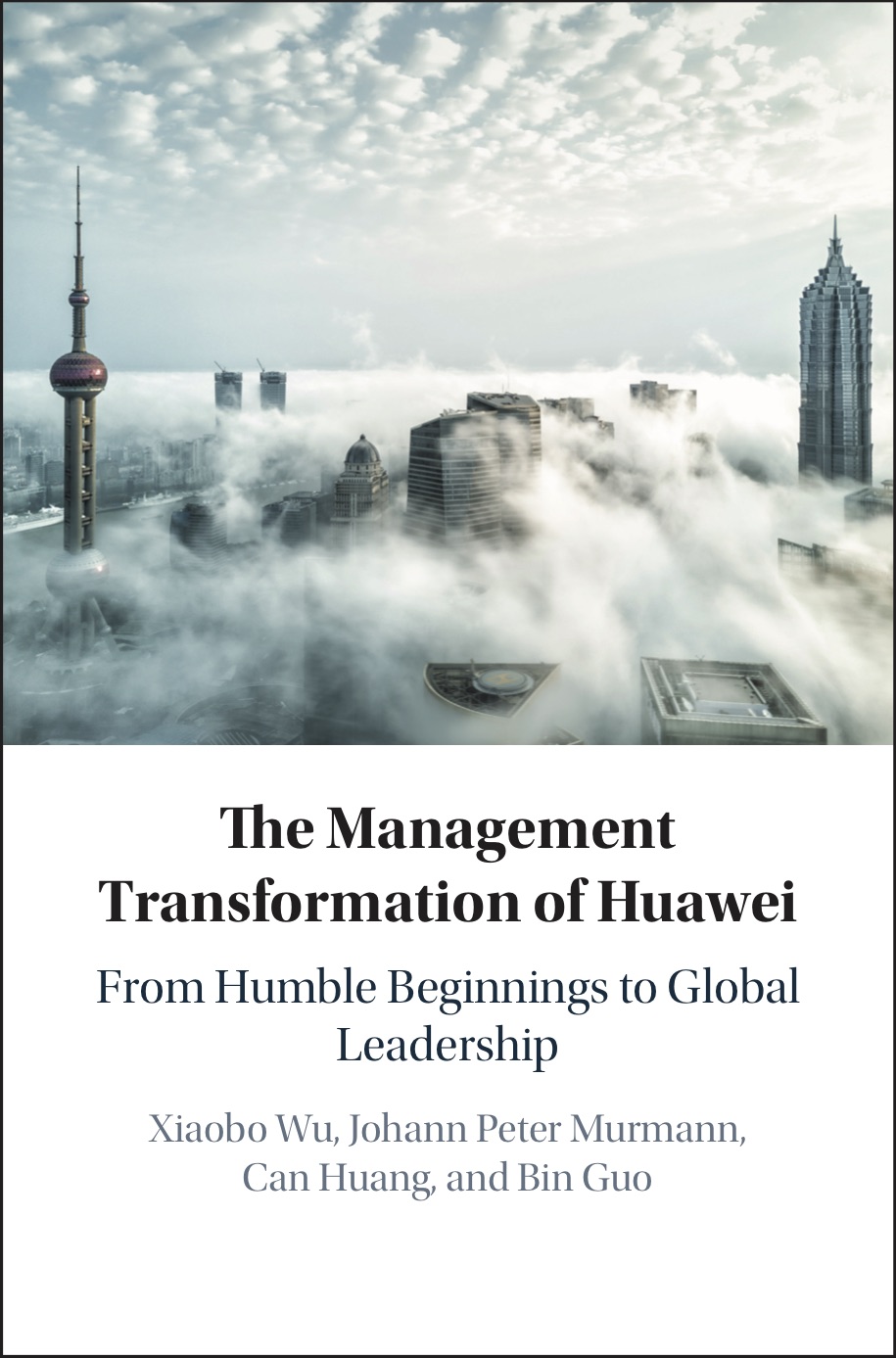
Endorsements
‘This is a ‘must read’ book for whoever is interested in the rise of China. It provides unique empirical and conceptual insights on China’s leading company and draws on world class researchers for analysis and commentaries. Uniquely valuable!’
—Yves Doz, Solvay Chaired Professor of Technological Innovation, INSEAD
‘The Management Transformation of Huawei provides a fascinating account of how Huawei preserved its entrepreneurial spirit as it rapidly scaled up over its 30-year history. Very few studies provide such an in-depth historical account of the evolution of a company over such a long period of time. Any scholar or practitioner interested in understanding the leadership challenges that arise with rapid organizational growth should read this book.’
—Ranjay Gulati, Paul R. Lawrence MBA Class of 1942 Professor of Business Administration, Harvard Business School
‘Huawei has become a major player in the global electronics industry and has been - perhaps unwantedly - cast into the role of a significant geopolitical force. This book is important and interesting because of the astonishing story of Huawei’s corporate growth. The authors provide an insightful account of how Huawei transformed itself from a small startup into a global giant, making an important scholarly contribution under major headings of the strategic management literature, such as ‘knowledge’, ‘routines’ and ‘dynamic capabilities’.’
—Sidney G. Winter, Deloitte and Touche Professor Emeritus of Management, Wharton School, University of Pennsylvania
Cambridge University Press Book page
Categories: Bookshelf | China | Innovation | Management | Publications | Writing |

Why gave hydrogen-powered car not become mainstream even though they were hyped in already in 1974
GM had a hydrogen-powered bus in 1967. VW and Mercedes had experimental hydrogen-powered cars in mid-1970s. Here is a list of vehicles produced by various companies. WSJ.com has produced a great video explaining why hydrogen cars are still not around the corner, despite the technology’s great promise.
Categories: Innovation | Management |

The Innovation and Entrepreneurship Ecosystem in India
India began the process of market liberalization that opened it to significant interactions with the world economy in 1991. In this essay, we provide an overarching view of the country’s journey toward integration with the global innovation and entrepreneurship network. Major nodes in this global network have two major components that may be metaphorically referred to as ‘pillars and ivy’. Globally connected multinational enterprises (MNEs) form the pillars. Agile startups are the ivy, and their success (metaphorically, the height to which they can climb) depends on their symbiotic connections with the pillar MNEs. Both components are essential and reinforce each other. Without MNEs, the scaling of startups is hampered. Without a vibrant population of startups, MNEs’ interest in a location remains driven by cost, rather than capability and creativity. MNEs (mainly foreign) provided the initial sparks for the formation of the Indian innovation and entrepreneurship ecosystem. We chart the subsequent growth of India’s startups. They began in the information technology (IT) sector but now cover a much wider range of industries. Today, India’s innovation and entrepreneurship ecosystem is one of the largest in the world, with global integration in terms of technology, financing, human capital, and administration.
This is the introductory essay to a Special Issue of Management and Organization Review on The Innovation and Entrepreneurship Ecosystem in India.

Categories: Entrepreneurship | Innovation |

What Does the Success of Tesla Mean for the Future Dynamics in the Global Automobile Sector?
After reading Jacobides, MacDuffie, and Tae (2016), the success of Tesla in launching a new automobile company in a crowded sector puzzled us. Jacobides, MacDuffie, and Tae (2016) had convinced us that developing the capabilities to become the manufacturer of a complete, safe automobile system would be quite difficult. Researching the development history of Tesla, we have pieced together the key features of how Tesla achieved its successful entry into the automobile sector. From this we have concluded, based on the development time and costs associated with the Tesla Model S, that a well-funded company could develop a new electric vehicle (EV) from scratch and move it into production within 3 to 5 years, by spending $1–2 billion of capital for design, development, and manufacturing. Without a doubt, increasing production to the levels of mass producers would take much longer, but the Telsa example demonstrates that new entry into the industy has become feasible. Tesla’s trajectory, from start-up on the brink of bankruptcy to a company mass producing electric vehicles within 5 years, raises important questions about the future of the global automobile sector. What would prevent Apple and Google, two companies that clearly have the resources to fund $2B in R&D, from entering the market and contesting fiercely with the dominant OEMs such as GM, Ford, VW, Mercedes, and Toyota? There are already many ventures in the Chinese electric automobile sector, such as BYD, Qiantu, NIO, and many more. Inspired by the success of Tesla, why would Chinese software and internet giants such as Tencent and Alibaba not enter this large market given that Tesla did not have prior experience and was able to get a successful car ready for sale within 5 years? In this perspective piece, we offer our reflections on the implications of the success of Tesla for the dynamics of the global automobile sector. We will appraise the chances that Chinese firms will for the first time become leading players in pushing the frontier of automotive technology, a goal that has eluded them over the past 30 years despite massive government efforts to create strong home-grown auto companies.
There are three commentaries on our articles that make for a very spirited debate.
D. Teece “Tesla and the Reshaping of the Auto Industry” Management and Organization Review, 2018.
Finally, Liisa Välikangas provides an introduction to the “Forum on Tesla and the Global Automotive Industry” Management and Organization Review, 2018.

Categories: China | Economics | Management | Writing |

Interview with Professor Denise Rousseau
If you have been taught that relationship conflict (A-conflict) in teams is bad for team performance but arguing about tasks (C-conflict) is good, I encourage you to read my wide-ranging interview in BusinessThink with Professor Denise Rousseau (Carnegie Mellon University), the originator of this idea. After seeing the systematic evidence, she changed her mind and now is a leader in the movement to make management practice more evidence-based. I learned a lot from her while she was distinguished visiting scholar at UNSW earlier this year. To help spread her important message about evidence-based management, I interviewed Denise for BusinessThink. Watch a video of this interview or read the edited transcript that appeared originally in BusinessThink. If you like it, please share it!
Categories: Management | Psychology |

More Exploration and Less Exploitation: Cultivating Blockbuster Papers for MOR
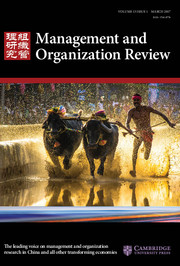 Let me invite you to travel in your mind to the year 2030. Imagine that you are one of the Senior Editors of MOR and have been asked by the Editor-in-Chief to write a short retrospective on the previous 15 years. Delighted to take on this task, you compose an editorial along these lines:
Let me invite you to travel in your mind to the year 2030. Imagine that you are one of the Senior Editors of MOR and have been asked by the Editor-in-Chief to write a short retrospective on the previous 15 years. Delighted to take on this task, you compose an editorial along these lines:
Dear MOR readers and contributors:
Thomson Reuters has just released its journal impact factor ranking for 2029. For the past five years, we have ranked in the top 15 out of 220 management journals, and last year, for the first time, we ranked fifth. This is a large improvement from 15 years ago, when we ranked at no. 33 out of 192 management journals. Even more positively, a recent poll by the Academy of Management, whose non-US membership has now exceeded 80% from a little over 50% in 2015, revealed that MOR has been found to be one of the top five journals that Academy of Management (AOM) members consistently read. In the qualitative section of the AOM survey, respondents offered comments such as:
‘If you want to get a deep understanding of key management problems that transforming economies face, then MOR is by far your best source’.
‘I was never much interested in Africa, but after reading the article in MOR that documented a genuinely new organizational form in Kenya, I was inspired to partner with a scholar at University of Nairobi to develop potentially new theoretical insights by comparing alliance governance practices in Kenya and in Brazil’.
‘Many of the top management scholars first try to get their work published in MOR. The journal has developed a reputation for publishing the freshest ideas. I think this is in large part because in MOR management scholars have more consistently partnered with scholars from non-obvious fields, such as urban planning, public policy, public administration, cultural anthropology, environmental engineering, and development studies, which proved particularly useful to understand Chinese management challenges’.
‘I follow MOR closely since there is always a good chance that I will come across an article that later turns out to be real blockbuster. This allows me to build on these creative articles before everyone else does’.
These statements are compelling evidence that MOR has developed a strong reputation beyond the narrow Thomson Reuters impact factor score, which fluctuates more from year to year at MOR than at other journals because of MOR’s long-standing strategy of cultivating blockbuster papers, rather than a continual series of incremental papers.
It would be foolish for us to think that MOR’s success is simply due to having recruited more brilliant editors than those at other journals. Clearly, elements of luck are involved in why MOR has become so influential that have little to do with the skills of past editorial teams. MOR benefited greatly from the general trend in which the countries regarded as transforming economies in 2015 (e.g., China, Indonesia, India, Pakistan, Bangladesh, the Philippines, Brazil, Nigeria, Ethiopia, Egypt) increased their share of the world economy much more rapidly than was predicted that year.
But we can also credit explicit strategies for MOR’s success: first, Arie Lewin’s (2014) push to broaden MOR from a China-focused journal to one focused on all transforming economies; second, a systematic push to motivate authors to write and submit papers that had the potential to push scholarship in a new direction; third, the development of an ethos that motivated editors and reviewers to go the extra mile to nurture creative papers even before they were submitted to the journal.
Looking to the future, our greatest challenge will be maintaining these strategies and not losing our cool when the impact factor drops for a year or two before another set of blockbuster papers raises it again. Today, let us celebrate what MOR has achieved over the past 15 years. Thanks are due to all the authors and editors who made this possible.
Now let us return to the here and now and discuss more explicitly some of the strategies that we have already put in place to increase the chances that MOR will become the home of blockbuster papers. Building on the themes of this imaginary 2030 editorial, I now want to articulate additional strategies that we should implement to attract more blockbuster papers.
Continue Reading on the MOR website at Cambridge University Press.
Categories: China | Management |

Using Simulation Experiments to Test Historical Explanations
I wanted to test with a computer simulation the explanations I offered in my book Knowledge and Competitive Advantage: The Coevolution of Firms, Technology and National Institutions for why German firms overtook their French and British competitors in the Synthetic Dye Industry from 1857-1913. So I partnered with Thomas Brenner who has created a simulation model that can replicate the key stylistic facts we know about firm and industry growth patterns. Our paper is now published online the Journal of Evolutionary Economics.
Conducting Simulation Experiments to Test Historical Explanations: The Development of the German Dye Industry 1857-1913
Abstract: In a simulation experiment, building on the abductive simulation approach of Brenner and Werker (2007), we test historical explanations for why German firms came to surpass British and France firms and to dominate the global synthetic dye industry for three decades before World War 1 while the U.S. never achieved large market share despite large home demand. Murmann and Homburg (2001) and Murmann (2003) argued that German firms came to dominate the global industry because of (1) the high initial number of chemists in Germany at the start of the industry in 1857, (2) the high responsiveness of the German university system and (3) the late (1877) introduction of a patent regime in Germany as well as the more narrow construction of this regime compared to Britain, France and the U.S. We test the validity of these three potential explanations with the help of simulation experiments. The experiments show that the 2nd explanation—the high responsiveness of the German university system— is the most compelling one because unlike the other two it is true for virtually all plausible historical settings.
Categories: Innovation | Economics | Methodology | Publications |

“The Moon and the Ghetto” revisited by Richard Nelson
Richard Nelson explained why is worthwhile to revisit his book.
Over thirty years ago I wrote an extended essay, The Moon and the Ghetto, concerned with the troubling question of why societies so rich and capable technologically and organizationally as to be able to land a man on the moon seemed unable to deal effectively with e.g. poverty, illiteracy, slums. I argued that, while politics was part of the reason, in many cases the problem was that our scientific knowledge and technological know-how was not sufficient to point the way to a solution. The general problem of the great unevenness of human progress has not gone away. The questions explored in this seminar are, first, what lies behind the great unevenness of scientific and technological progress. And second, under what conditions does it make sense to seek a solution to a problem by trying to develop stronger know-how. Can progress be made by reorienting our innovation systems?
You can watch his lecture given at INGENIO in Spain on Youtube.
Categories: Lectures | Innovation |
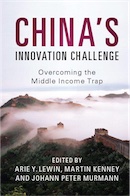
“China’s Innovation Challenge” published with Cambridge University Press
Arie Lewin, Martin Kenney and Johann Peter Murmann edited a new book on China’s Innovation Challenge: Overcoming the Middle-Income Trap.
New March 2016: Download Fronter Matter and Introductory Chapter
The book will also feature contributions from Justin Yifu Lin, Gordon Redding, Michael Witt, Keun Lee, Douglas Fuller, John Child, Simon Collison, Yves Doz, Keeley Wilson, Silvia Massini, Keren Caspin-Wagner, Eliza Chilimoniuk-Przezdziecka, Weidong Xia, Mary Ann Von Glinow, Yingxia Li, Zhi-Xue Zhang and Weiguo Zhong, Chi-Yue Chiu, Shyhnan Liou, and Letty Y-Y. Kwan, and Rosalie Tung.
Join discussion and get updates on the book by following its Facebook Page.

Categories: Bookshelf | China | Innovation |
Review of “China’s Path to Innovation” by Xiaolan Fu
To date there are few research monographs that go beyond picking out striking cases of innovative companies. We clearly also need systematic analyses of China’s growing innovative capacity. For this reason, Xiaolan Fu’s book China’s Path to Innovation (Cambridge University Press, 2015) is a welcome addition to the literature. Fu is Professor of Technology and International Development at Oxford and has written about innovation in China for more than ten years. China’s Path to Innovation has 16 chapters (Table of Contents). The book provides an excellent overview of scholarly literature on the development of Chinese innovative capacities. It deserves to be in the library of anyone working on China’s innovative capacity. Read my full review on economic-evolution.net.
Categories: Bookshelf | China | Publications |

Deepening the Conversation Between Business History and Evolutionary Economics
This article has appeared in the journal “Business History”, Volume 57, Issue 5, 2015.
Abstract: How can business historians and evolutionary economists deepen their conversations? The paper argues that in doing detailed studies of how individual firms develop capabilities over time is where the concerns of business historians who want to tell the history of individual firms and the concerns of evolutionary economists overlap. This is area where more extensive interactions would be most productive.
This paper is a commentary on two articles:
1. Constructing an ‘industry’: the case of industrial gases, 1886–2006 by Ray Stokes & Ralf Banken
2. The evolution of the pharmaceutical industry by Franco Malerba & Luigi Orsenigo
Categories: Publications |
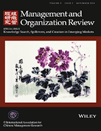
Tips for Choosing Appropriate Level of Abstractions (especially for Chinese Researchers)
A lot of Chinese researchers simply want to imitate how top American journals in formulating theories without boundary conditions. This sounds like doing good science but more often its leads to superficial analyses that do not explain what is happening in China. I was asked to write a commentary on an article by Child and Marinova (2014) in Management and Organization Review and this gave me a chance to reflect more broadly on choosing the appropriate level of abstraction in social science Research. The article is now published.
Reflections on Choosing the Appropriate Level of Abstraction in Social Science Research. 关于在社会科学研究中选择适当的抽象水平的反思
Abstract: Although researchers often do it subconsciously, every explanation involves choosing a level of abstraction at which the argument proceeds. The dominant North American style of research in Organization Theory, Strategy, and International Business encourages researchers to frame their explanations at the highest level of abstraction where country-level contextual factors are suppressed or ignored. Yet to provide powerful explanations for recent developments in China, researchers are drawn to a greater level of context specificity. This tension is evident in the Child and Marinova (2014) paper. One way to reduce the tension is to identify general causal mechanisms that combine in different ways to produce different results depending on context. This research strategy is more effective than seeking invariant, general patterns of development across all times and places.
Keywords: choosing level of abstraction;philosophy of social science;research design;research on industries;research on firms 选择抽象的水平;社会科学的哲学;研究设计;行业研究;企业研究

Categories: China | Entrepreneurship | Publications |

The role of home country demand in the internationalization of new ventures
My article with Salih Ozdemir and Deepak Sardana was just published in Research Policy.
Abstract: International new ventures (INVs) have been documented to exist all around the world, but the literature is silent on the frequency of such companies in different countries. We contend that the propensity of new ventures to internationalize by forming international partnerships is higher in small-domestic demand countries because they have a greater motivation given their limited local demand. After discussing the methodological challenges in testing this hypothesis, we do such a test by studying alliances in the health segment of the biotech industry in relatively small-domestic demand countries (Australia, Israel, and Taiwan) and by comparing the results with five large-domestic demand countries (UK, Germany, France, US, and Japan). We find that young firms in the countries with smaller domestic demand are at least 3 times more likely to enter into international partnerships than their counterparts in countries with larger domestic demand. We further demonstrate that this difference can primarily be explained by the difference in the size of domestic healthcare markets rather than other underlying opportunity structure related factors.
Keywords: International new ventures; Internationalization; Small vs. large demand countries; Young biotechnology firms; International partnerships; Business development partnerships

Read and Download Full Article here
Categories: Entrepreneurship | Innovation | Publications |

